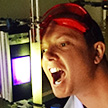Related Questions
- How thick is our skin?
- Hello, we were just going to ask if you can help us on our scientist experiment on our inquiry topic witch is how is global warming affecting the earth thank you.
- is lead with hydrochloric acid a redox reaction? if so, please explain the formation of precipitate lead chloride.
- How does an iPad work?
- My brother says there is a number called googolplex does it exist?








The technical term is “diffraction”. Tiny particles in the upper air reflect mostly red light, leaving more blue light to come through (some red light gets through too – otherwise red things would look black).
The reason red light is reflected more than blue is to do with the size and spacing of the particles.
0
@bigbrain Such a good question – everyone wonders this! Sunlight reaches Earth’s atmosphere and is scattered in all directions by all the gases and particles in the air. Blue light is scattered in all directions by the tiny molecules of air in Earth’s atmosphere. Blue is scattered more than other colours because it travels as shorter, smaller waves. This is why we see a blue sky most of the time.
NASA have a great site that helps to explain: http://spaceplace.nasa.gov/blue-sky
0
Those are really good answers, so I’ll just add a few details. This scattering effect is also why we see red sunsets/sunrises — the blue light is scattered away from the direction you’re looking, so the sky looks red instead.
Interestingly, if you’re ever in a place with very low pollution, you can sometimes even see a GREEN sunset (not the whole sky of course, just a bit right near the sun). I’ve actually seen a couple such “green flashes” when I’ve been up on a mountain doing observing with my telescope.
0